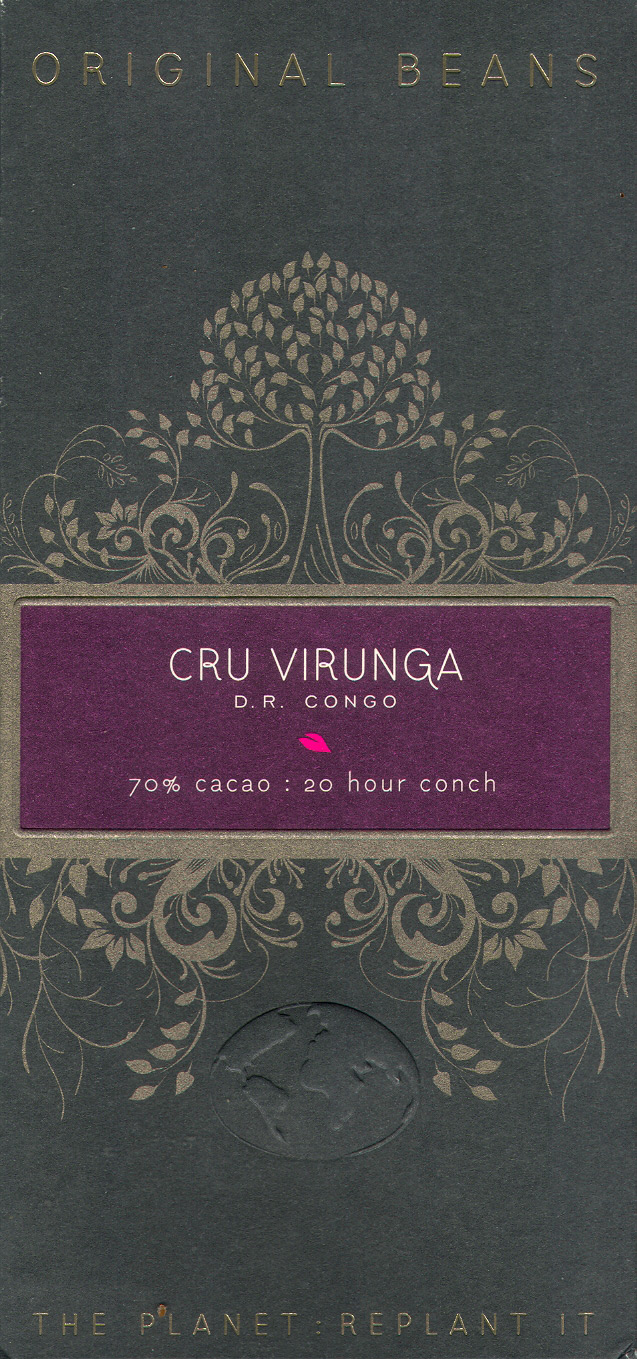Impact
Many skeptics rightfully charge that so much int'l aid flows into relief zones that they should be renamed; ATM Darfur, or the Palestinian Money-Machine for instance; that NGOs there stand hell-bent ready to maintain dire conditions to keep those causes afloat.
Original Beans, the brand fronting this bar manufactured behind-the-scenes by Felchlin, brings to market an ethical chocolate play similar to Plantations - rainforest conservation, fair-trading, organic-leaning, etc. - under the straining motto "The Planet / Re-plant It" -- the happy flipside to the "Gen. Betray Us" skool of rhymes.
This release hails from The Congo. Just the sound of it bears down with a certain tonnage. Conjures up the Lost World novel of the same name by Michael Crighton: grey gorilla hybrids, magic diamonds, & bushmeat in the city of Zinj (alternate spelling of Zanj – Arabic for “Land of the Blacks”).
But no monkey business here, this chocolate is all serious.
Original Beans, the brand fronting this bar manufactured behind-the-scenes by Felchlin, brings to market an ethical chocolate play similar to Plantations - rainforest conservation, fair-trading, organic-leaning, etc. - under the straining motto "The Planet / Re-plant It" -- the happy flipside to the "Gen. Betray Us" skool of rhymes.
This release hails from The Congo. Just the sound of it bears down with a certain tonnage. Conjures up the Lost World novel of the same name by Michael Crighton: grey gorilla hybrids, magic diamonds, & bushmeat in the city of Zinj (alternate spelling of Zanj – Arabic for “Land of the Blacks”).
But no monkey business here, this chocolate is all serious.
Appearance 4.7 / 5
| Color: | UPS brown |
| Surface: | perfect |
| Temper: | glazed |
| Snap: | plonks; gravel edge |
Aroma 7.8 / 10
big tobacco & snapping coffee embed light orange + a beautifully unexpected white cherry blossom, all of it together hiding some Okapi scent glands (tar, lava, & clay) -> aerates baby powder but coffee rules out
Mouthfeel 12.2 / 15
| Texture: | crumble cake collapses all about... |
| Melt: | ... soft butter shards |
Flavor 44.1 / 50
chocolate cake mix -> jujube date -> chocolate salvo around a blood-orange to grapefruit-pith... shoots cara cara F/Xs thru the length to faint white roses & cherry blossoms over breadfruit -> whispering cloves -> mulberried coffee grounds -> sweet bushmeat -> soft cashew brownie -> winds off fractional ylang (its licorice-like component)
Quality 18.4 / 20
Simple (perhaps best as a foundation for a blend selection which is no knock against it) & yet enough subliminal enharmonics (by no means fleeting but lingering) to keep the interest levels locked-in.
Surface & Snap give this away: hyper-tempered / hypo-conched (unusually rare for Swiss-process) & for good reason. Any aggressive agitation would just wipe away the subtle acidity in these beans. They were well-fermented & dried, to which a medium-high roast is applied, generating a lot of naked chocolate flavor with virtually no bitterness (helped in this regard by copious amounts of cacáo butter). It results in a preceived sweetness greater than the actual sugar content & sets this east Congo cacáo apart - both geographically & genetically - from groves in the country’s western territory -- those conforming more toward typical West African Amelonado.
Instead, this bears some resemblance to cacáo out of Tanzania, confirming a general regional character, particularly in its bread factor & orange aspect.
Cacáo growing in Congo’s Mavivi Nat’l Park presumably forms an extension of the East Africa plantations first established by German colonists at Usumbara (around Burundi) towards the end of the 19th century based on material from Cameroon. Shortly thereafter the Brits planted some in their Uganda colony at the Entebbe Botanic Station with transplants that were originally sourced, in all probability, from Trinidad (mixed varieties of red & yellow Calabacillo with a smattering of Criollo) via the Royal Gardens back in England.
ING: cocoa mass, sugar, cacáo butter; CBS (Cocoa-Butter-Sugar ratio) ~1.5:3:2
Reviewed Summer 2010
Surface & Snap give this away: hyper-tempered / hypo-conched (unusually rare for Swiss-process) & for good reason. Any aggressive agitation would just wipe away the subtle acidity in these beans. They were well-fermented & dried, to which a medium-high roast is applied, generating a lot of naked chocolate flavor with virtually no bitterness (helped in this regard by copious amounts of cacáo butter). It results in a preceived sweetness greater than the actual sugar content & sets this east Congo cacáo apart - both geographically & genetically - from groves in the country’s western territory -- those conforming more toward typical West African Amelonado.
Instead, this bears some resemblance to cacáo out of Tanzania, confirming a general regional character, particularly in its bread factor & orange aspect.
Cacáo growing in Congo’s Mavivi Nat’l Park presumably forms an extension of the East Africa plantations first established by German colonists at Usumbara (around Burundi) towards the end of the 19th century based on material from Cameroon. Shortly thereafter the Brits planted some in their Uganda colony at the Entebbe Botanic Station with transplants that were originally sourced, in all probability, from Trinidad (mixed varieties of red & yellow Calabacillo with a smattering of Criollo) via the Royal Gardens back in England.
ING: cocoa mass, sugar, cacáo butter; CBS (Cocoa-Butter-Sugar ratio) ~1.5:3:2
Reviewed Summer 2010





